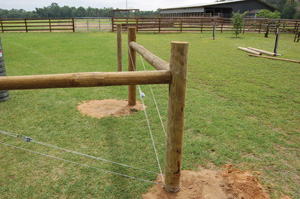Your fence may be one of your biggest property investments this year, so be sure it’s properly installed by using the correct materials and installation techniques. We can’t stress enough that fencing is only as strong as the fence post it’s secured to. The best fencing product in the world can’t protect your livestock if it can’t withstand animal pressure and the elements.
Corner and Brace Posts – The Fence’s Foundation

Corner posts and brace assemblies serve as the foundation for the entire construction process. These elements are critical to the overall stability of a fence. By anchoring the fence at its corners, these posts give the fence its strength. All the extreme tension from the fence structure is held at the corners. Therefore, proper selection, installation and bracing of the corner posts is essential to prevent fence failure.
The principle of bracing a corner post is simple. The greatest tension is along the horizontal wire furthest from the ground. As a result, wire fence will exert tremendous pressure on the corners. With each horizontal wire potentially tensioned to several hundred pounds, the pull on the corner posts can be immense. Other factors adding stress to the corner posts are changes in temperature, which will cause the wire to expand and contract, and animals leaning against or challenging the wire. For these reasons, the importance of the corner brace in the overall durability of your fencing cannot be overstated.
Selecting Corner Posts
Typically, corner posts are made of treated wood. Never use steel t-posts, as they’re just not strong enough to serve as the foundation for your fence. Select posts of an adequate size and material to withstand stress, and take care to ensure that the corners are well grounded and braced.
- Use wood posts that have been treated with preservatives to help guard against decay.
- Corner posts generally need to be 6-8 inches in diameter, 8 feet long and set a minimum of 3-1/2 feet deep.
- To determine the proper length, add together the depth of setting, which should be no less than 3-1/2 feet in the ground, plus the height of the top wire above the ground, plus 6” extra. For example, a corner brace post set 3-1/2’ for a 4’ fence would have to be 8’ long.
Line Posts – Adding Stability

Line posts support the material intermittently along the length of each side of the fence. A proper installation will include both wooden and t-posts.
- In most cases, we recommend spacing the posts 8-12 feet apart, depending on the length of the fence line and the material being used.
- Typically, a ratio of 5 steel posts to 1 wood post provides a sturdy and reliable enclosure.
- Determine the proper size wooden post for the amount of fence you’re installing. The larger the top diameter, the stronger the post. For example, a 4” post has twice the strength of a 3” post, while a 5” post has four times the strength of a 3” post.
- The description of steel T-posts will help you determine its strength. A 1.33 post weighs 1.33 pounds per foot, while a 1.25 post weighs 1.25 pounds per foot.
- When selecting line posts, be sure that the posts are at least 3” taller than the fence they are supporting. Line posts need to be set 2’ – 2-1/2’ deep.
Red Brand T-Posts
T-posts are a popular alternative to wooden line posts because they are easier to drive into the ground. Additionally, they weigh less than wood and can serve as grounding against lightning when the soil is moist. Red Brand T-Posts are American-made, assuring the same reliable quality as all of our fence products. The combination of red-topped T-Posts with any of our Red Brand fence products creates a professional, finished look that stands out in any field, while providing exceptional durability.
Proper Installation Techniques
Red Brand fence products are an investment in quality, and posts play a critical role in determining longevity. When properly installed, a Red Brand fence can be expected to last 20-25 years or more. Whether you choose to hire a contractor or prefer to install fencing on your own, we can’t stress correct installation practices enough. Ensure that your fence is installed properly by using correct materials and bracing techniques.
To help walk you through the entire process, Red Brand has created a comprehensive library of instructional videos that demonstrate the steps of fence installation, including Setting Posts and Bracing. For more information on installation techniques, visit redbrand.com or ask your local Red Brand dealer for assistance.
What side of the post?
In most instances, you will place your fence on the animal side of the post. This will prevent the staples from being pulled out as the animal puts pressure on the fence. The exception will be on property lines; check local regulations to ensure compliance when placing fencing along boundaries. Check out more Fence Planning FAQs at RedBrand.com.
Don’t miss a thing. Simply fill out the Subscribe form here. We’ll notify you every time we add new material. See you soon!

